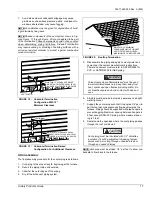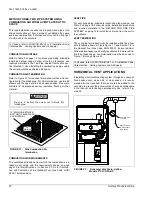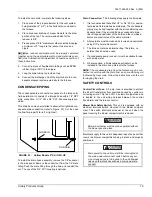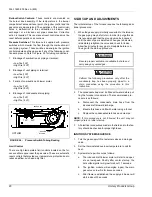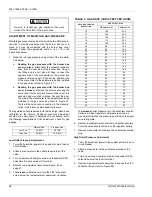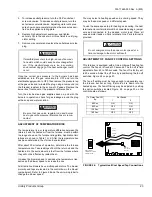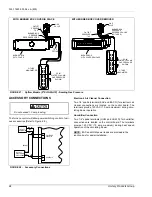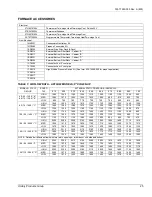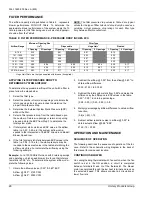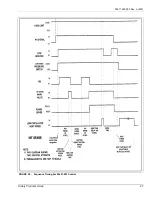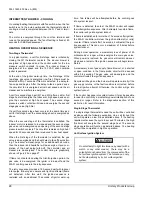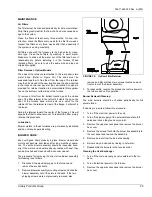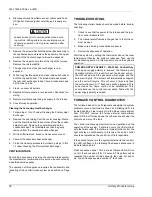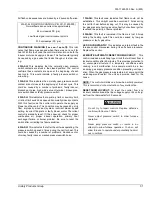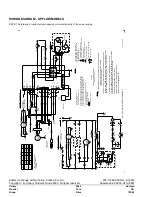
035-17480-000 Rev. A (800)
30
Unitary Products Group
4.
Disconnect wires from flame sensor, rollout switch and
HSI igniter. Remove igniter carefully, as it is easily bro-
ken.
5.
Remove the screws that hold the burner box assembly to
the vestibule panel and remove the assembly. The upper
portion of the heat exchanger will now be exposed.
6.
Remove the upper cover plate at the top of the furnace.
Remove the internal baffle.
7.
The upper portion of the heat exchanger is now
exposed.
8.
With a long flexible wire brush, clean inside each tube at
both the top and bottom. The brush must pass around
the rear heat exchanger tubes. Vacuum loose scale and
dirt from each tube.
9.
Clean - vacuum all burners.
10. Replace all components in reverse order. Reconnect all
wiring.
11. Restore electrical power and gas supply to the furnace.
12. Check furnace operation.
Cleaning the Secondary Heat Exchanger
1.
Follow steps 1 thru 10 under Cleaning the Primary Heat
Exchanger.
2.
Remove the vent piping from the venter housing. Discon-
nect the drain lines from the venter and from the conden-
sate drain pan. Remove the venter blower and the
condensate pan. The turbulators can then be gently
removed from the secondary heat exchanger.
3.
With a stiff wire brush, brush out loose scale or soot.
4.
Vacuum the secondary heat exchanger.
5.
Finish the cleaning procedure by following steps 10 thru
12 under Cleaning the Primary Heat Exchanger.
VENT/AIR INTAKE
Should it be necessary to service the vent/air intake system,
the manufacturer recommends this service be conducted by
a qualified service agency.
The operation of this appliance requires the reassembly and
resealing of the vent/air intake system as specified on Page
9.
TROUBLESHOOTING
The following visual checks should be made before trouble-
shooting:
1.
Check to see that the power to the furnace and the igni-
tion control module is ON.
2.
The manual shutoff valves in the gas line to the furnace
must be open.
3.
Make sure all wiring connections are secure.
4.
Review the sequence of operation.
Start the system by setting the thermostat above the room
temperature. Observe the system's response. Then use the
troubleshooting section in this manual to check the system's
operation. .
FURNACE CONTROL DIAGNOSTICS
The furnace has built-in, self diagnostic capability. If a system
problem occurs, a fault code is shown by a blinking LED. It is
located behind a clear view port in the blower compartment
door. DO NOT remove the furnace blower compartment
panel OR turn off furnace power as either action will clear the
control's memory of the fault.
The control continuously monitors its own operation and the
operation of the system. If a failure occurs, the LED will indi-
cate the failure code. If the failure is internal to the control, the
light will stay on continuously. In this case, the entire control
should be replaced as the control is not field repairable.
If the sensed failure is in the system (external to the control),
the LED will flash in the following flash-pause sequences to
indicate failure status.
Flash sequence codes 1 thru 4 are as follows. LED will turn
on for 1/4 second and off for 1/4 second. This pattern will be
repeated the number of times equal to the code. For exam-
ple, two on flashes equals a number 2" fault code.
Label all wires prior to disconnection when servic-
ing controls. Wiring errors can cause improper and
dangerous operation. Verify proper operation after
servicing.
POWER SUPPLY POLARITY - 50A51-243 Control Only
If the power supply polarity is reversed, the following unit
operation will occur. On a call for heat, the inducer will run,
the HSI will glow and the gas valve will energize and the
burners will ignite. The burners will immediately extinguish
and the unit will recycle. This will occur 3 times and then
the unit will lockout. A “7” flash code will be displayed. This
code means the flame could not be established. This
occurs because the control cannot sense flame with the
power supply polarity reversed.


